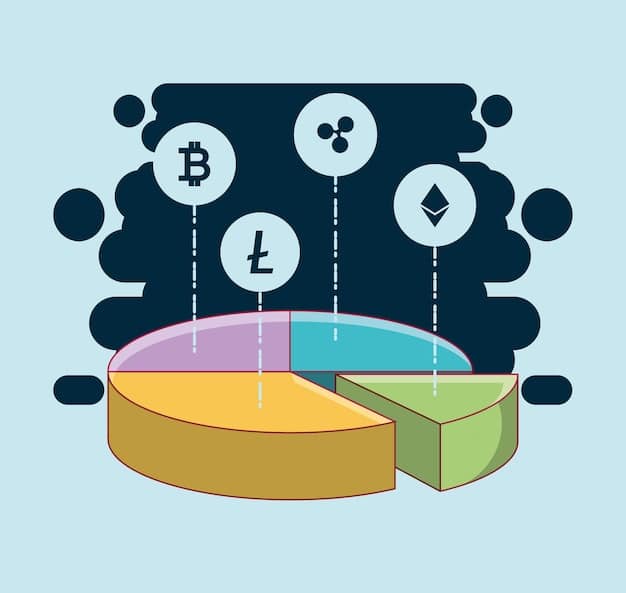How to Evaluate a Cryptocurrency Whitepaper: A US Investor’s Guide

Evaluating a cryptocurrency whitepaper involves scrutinizing its technical details, team credentials, tokenomics, and roadmap to assess the project’s viability and potential risks for US investors.
Investing in cryptocurrencies can be exciting, but it’s crucial to do your homework. One of the most important resources for understanding a new cryptocurrency is its whitepaper. This guide will show you how to evaluate the whitepaper of a new cryptocurrency before investing, specifically tailored for US investors.
Understanding the Purpose of a Cryptocurrency Whitepaper
A cryptocurrency whitepaper is a technical document that outlines the project’s purpose, technology, development roadmap, and team. It’s essentially a business plan for a cryptocurrency. Understanding its purpose is the first step in evaluating whether or not to invest.
Think of it as a detailed prospectus. It should clearly articulate the problem the cryptocurrency aims to solve, how it intends to solve it, and why its solution is unique. A well-written whitepaper will also provide insights into the tokenomics (the economics of the token), the development team, and the project’s future plans.
Why is a Whitepaper Important?
A whitepaper can help you determine the legitimacy and potential of a cryptocurrency project. It provides a comprehensive overview of the project, allowing you to assess its viability and potential risks. Without a solid whitepaper, it’s difficult to gauge the project’s credibility or its chances of success.
- Provides transparency and builds trust.
- Outlines the project’s vision and goals.
- Details the technical aspects of the cryptocurrency.
- Explains the tokenomics and distribution of tokens.
In conclusion, understanding the purpose of a cryptocurrency whitepaper is crucial for making informed investment decisions. It’s a valuable resource that provides essential information about the project’s vision, technology, and team. By carefully analyzing the whitepaper, US investors can assess the potential risks and rewards of investing in a new cryptocurrency.
Analyzing the Problem and Solution Presented
The heart of any good whitepaper lies in its articulation of a problem and the offered solution. This section is critical for US investors, as it determines if the cryptocurrency addresses a real-world need and if its proposed solution is viable and innovative.
Begin by identifying the problem the cryptocurrency aims to solve. Is it a genuine issue or a contrived one? Next, evaluate the proposed solution. Is it logically sound, technically feasible, and scalable? Consider whether existing solutions already address the problem and, if so, why the cryptocurrency’s solution is superior.

Assessing the Problem’s Validity
It’s crucial to critically assess the problem described in the whitepaper. Look for data or evidence to support the existence and significance of the problem. Be wary of vague or unsubstantiated claims. A legitimate problem should be well-defined and quantifiable.
Has the whitepaper mentioned any research that can prove the problem they are trying to address? Do other experts in the field recognize this as a real pain point?
Evaluating the Solution’s Feasibility
The proposed solution needs to be technically feasible and economically viable. Does the whitepaper offer a clear explanation of how the technology works? Does the solution rely on unproven technologies or unrealistic assumptions? How does the solution align with existing regulations and legal frameworks in the US?
- Look for a clear and concise explanation of the technology.
- Assess the scalability and efficiency of the solution.
- Consider the potential regulatory hurdles in the US.
- Evaluate the economic incentives for users and participants.
In conclusion, carefully analyzing the problem and solution presented in the whitepaper is essential for determining the potential of a cryptocurrency project. US investors should look for well-defined problems and technically feasible solutions that address real-world needs. By critically assessing these aspects, you can make more informed investment decisions.
Investigating the Tokenomics and Token Distribution
Tokenomics, or token economics, refers to the design and management of a cryptocurrency’s token supply. Understanding the tokenomics is crucial for US investors because it can significantly impact the value and potential of the cryptocurrency. This section addresses token distribution, supply limits, and how the token is used within the ecosystem.
Start by examining the token distribution. How many tokens are allocated to the team, advisors, and early investors? Are the tokens locked up for a certain period, and what percentage is available to the public? A large allocation to insiders without a vesting schedule can be a red flag.
Analyzing Token Supply and Demand
The whitepaper should clearly state the total token supply and its distribution mechanism. Is there a fixed supply, or is it inflationary? How are new tokens created, and what is the rate of inflation? Understanding the supply and demand dynamics is essential for assessing the token’s potential value.
Understanding Token Utility
The token should have a clear and compelling use case within the ecosystem. What purpose does it serve? Is it used for governance, staking, accessing services, or rewarding users? A token with limited utility may struggle to gain value and adoption.

- Examine the token distribution and allocation.
- Assess the token’s utility within the ecosystem.
- Understand the token’s supply and demand dynamics.
- Look for incentives for holding and using the token.
In conclusion, investigating the tokenomics and token distribution is critical for making informed investment decisions. US investors should carefully analyze the token allocation, supply dynamics, and utility to assess the long-term potential of a cryptocurrency. A well-designed tokenomic model can drive adoption and create value for token holders.
Checking the Team and Advisory Board’s Credentials
The team behind a cryptocurrency project is just as important as the technology itself. US investors need to scrutinize the team’s experience, expertise, and track record to assess their ability to execute the project’s vision. A strong team can increase confidence in the project’s legitimacy and potential for success.
Start by researching the team members and advisors listed in the whitepaper. Verify their credentials on professional networking sites like LinkedIn. Look for relevant experience in blockchain technology, finance, or the industry the cryptocurrency is targeting. Be wary of anonymous teams or individuals with questionable backgrounds.
Assessing Experience and Expertise
The team should have the necessary skills and experience to develop and market the cryptocurrency. Do they have a proven track record of building successful projects? Are they transparent about their backgrounds and qualifications? Look for evidence of technical expertise, business acumen, and marketing capabilities.
Verifying Team Members’ Online Presence
Cross-reference the team members listed in the whitepaper with their online profiles. Check their LinkedIn profiles, personal websites, and social media accounts. Do their profiles align with the information presented in the whitepaper? Any discrepancies could be a red flag.
- Research the team members and advisors.
- Verify their credentials and experience.
- Look for transparency and accountability.
- Assess their ability to execute the project’s vision.
In conclusion, checking the team and advisory board’s credentials is an essential step in evaluating a cryptocurrency project. US investors should look for experienced, transparent, and accountable teams with a proven track record of success. A strong team can increase confidence in the project’s potential and reduce the risk of investing in a fraudulent or poorly managed cryptocurrency.
Reviewing the Project’s Roadmap and Development Plan
A well-defined roadmap outlines the project’s milestones, timelines, and goals. US investors should carefully review the roadmap to assess the project’s progress, ambition, and realistic expectations. A clear roadmap can provide insights into the team’s vision and their ability to execute their plans.
Start by examining the roadmap for specific milestones and deadlines. Are the milestones realistic and achievable? Does the roadmap include specific deliverables, such as product launches, partnerships, or technological advancements? Be wary of vague or overly ambitious roadmaps without concrete plans, without deadlines.
Evaluating the Project’s Milestones
The roadmap should include specific, measurable, achievable, relevant, and time-bound (SMART) goals. Each milestone should have a clear objective and a realistic timeframe for completion. Look for evidence that the team has met past milestones and is on track to achieve future goals.
Assessing the Development Progress
Evaluate the project’s development progress by checking their GitHub repository, blog, and social media channels. Are they actively developing the technology? Do they provide regular updates on their progress? A lack of development activity could be a sign that the project is stalled or abandoned.
- Review the project’s roadmap for milestones and timelines.
- Evaluate the realism and feasibility of the milestones.
- Assess the project’s development progress and activity.
- Look for evidence of past achievements and future plans.
In conclusion, reviewing the project’s roadmap and development plan is crucial for assessing its potential for success. US investors should look for realistic and achievable milestones, evidence of development progress, and a clear vision for the future. A well-defined roadmap can increase confidence in the project’s legitimacy and potential for growth.
Assessing Regulatory Compliance and Legal Considerations for US Investors
Navigating the complex regulatory landscape is a crucial aspect of cryptocurrency investing for US investors. Understanding the legal considerations and compliance requirements is essential for avoiding potential pitfalls and ensuring the legality of your investments.
Start by researching the project’s legal status in the US. Does the cryptocurrency comply with Securities and Exchange Commission (SEC) regulations? Has the project sought legal counsel to ensure compliance with applicable laws? Be wary of cryptocurrencies that operate in legal gray areas or actively evade regulations.
Understanding SEC Regulations
The SEC has regulatory authority over cryptocurrencies that are considered securities. A cryptocurrency may be classified as a security if it represents an investment contract, where investors expect to profit from the efforts of others. Understanding the SEC’s stance on cryptocurrencies is crucial for avoiding legal issues.
Considering Tax Implications
Cryptocurrency investments are subject to US tax laws. The Internal Revenue Service (IRS) treats cryptocurrencies as property, meaning that gains and losses from trading or selling cryptocurrencies are subject to capital gains taxes. It’s essential to keep accurate records of your cryptocurrency transactions for tax reporting purposes.
- Research the project’s legal status in the US.
- Understand SEC regulations and their implications.
- Consider the tax implications of cryptocurrency investments.
- Seek legal counsel if you have any doubts or concerns.
In conclusion, assessing regulatory compliance and legal considerations is essential for US investors. Understanding the legal landscape, SEC regulations, and tax implications can help you make informed investment decisions and avoid potential legal issues. It is crucial to exercise caution.
| Key Aspect | Brief Description |
|---|---|
| 🔎Problem Analysis | Verify the significance and validity of the problem. |
| 🪙 Tokenomics | Understand token distribution, supply, and utility. |
| 👨💻 Team Credentials | Assess experience and transparency of the team. |
| 📅 Roadmap | Review if the product roadmap looks realistic and attainable. |
FAQ
A cryptocurrency whitepaper is a detailed document outlining a project’s goals, technology, and plans. It’s a crucial tool for investors to understand the project and assess its potential before investing.
Verify the team’s credentials by checking their LinkedIn profiles, online presence, and past projects. Look for relevant experience and expertise in blockchain technology or related fields to assess their credibility.
Red flags include vague language, unrealistic promises, lack of detail on technology or tokenomics, an anonymous team, and a roadmap that is not realistic.
Critically important. Regulations can significantly impact a cryptocurrency’s viability, particularly in the US. Fully understand how existing, and proposed regulations might affect the project.
No, the whitepaper is just one piece of the puzzle. Conduct thorough research, seek advice from financial advisors, and diversify to manage risk. Never invest more than you can afford to lose.
Conclusion
Evaluating a cryptocurrency whitepaper is a crucial step for US investors looking to make informed decisions. By carefully analyzing the problem, solution, tokenomics, team, roadmap, and regulatory compliance, you can assess the potential risks and rewards of investing in a new cryptocurrency. Remember to do your research, seek advice, and invest wisely.





